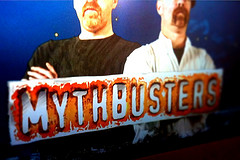 Do the names Adam Savage and Jamie Hyneman ring a bell? They’re the hosts of the popular Discovery Channel Show, “MythBusters,” the series that claims “The Challenge is simple. Pick a myth and then test it.” These two men investigate the absurd myths we hear and let viewers know whether or not there’s truth behind them.
Do the names Adam Savage and Jamie Hyneman ring a bell? They’re the hosts of the popular Discovery Channel Show, “MythBusters,” the series that claims “The Challenge is simple. Pick a myth and then test it.” These two men investigate the absurd myths we hear and let viewers know whether or not there’s truth behind them.
That’s what we’re doing here today. There are a number of myths about IT consulting; that it’s risky, that it’s not profitable, that the taxes are confusing and that it takes too much effort. We’re going to bust these five myths.
Adam and Jamie would be proud.
Myth 1: It’s risky.
There’s a common perception that contractors are risking their professional lives to take a contract position. Many worry that they’ll show up and, despite their best efforts, will be unable to live up to the company’s expectations. They fear that, as a result, their position will be terminated while they are left back at square one; unemployed and looking for a new job.
While this could happen to an IT consultant, it could also happen to a full-time employee. People used to work at one company for 40 years but this is no longer the case. Companies let employees go left and right, regardless of their full-time or contract status. All in all, there’s the same amount of risk in being an IT consultant as there is in being a full-time IT employee.
Myth 2: Taxes are confusing and difficult.
If you’re a technical consultant, another common perception is that the taxes that already make you want to bang your head off of the wall are made all the worse by your contract position.
This isn’t the case. If you are a contract IT consultant, you can file as a W2, making you no different than a normal employee. It’s the same headache everyone else has.
Myth 3: Incorporating is hard and expensive
While you can file your taxes as a W2, you can also incorporate. Many people believe that this is a time-consuming, not to mention expensive, process.
It isn’t. You can spend anywhere from $100 – $1,000 depending on your legal resources. LegalZoom, a website dedicated to online legal document preparation, is a cheap and quick way to incorporate yourself.
Myth 4: The lack of benefits makes it un-profitable/less profitable than full-time employment.
When you’re a full-time employee, you get benefits such as health care, 401K and vacation. Some argue that this is real money in your pocket, money you receive when you’re not working.
While you may not be getting matching funds in your retirement account, you will be making approximately 50-90% more money than you would in a similar full-time employee position. For example, if you normally make $75,000 at your full-time job, you would be making anywhere from $100,000 to $140,000 a year. This increase in your rate is enough to cover the expenses that would normally be benefits of your full-time employee status.
Myth 5: It takes too much effort to stay engaged in contracts.
We’ve all done the job search; it takes a lot of time, patience and energy. The thing is, once you get a job, you dread going through the process again. Hence, the perceived problem with being an IT contract consultant. Many think, if I’ve just landed a job, I don’t want to go through this again in a year.
Here’s the thing though; if you have a good recruiting agency, they’ll do the work for you. Good companies spend a tremendous amount of capital and resources in advertising and marketing to get you the next job. If you take the time to find a good recruiting agency; you won’t have to do the work. They’ll simply hand you your next position.
Conclusion:
While we didn’t get to drop dummies from hundreds of feet or play with explosives like Adam and Jamie, we’ve debunked five of the most common IT consulting myths. And what have we learned? It doesn’t take as much effort or risk to be a technical consultant as everyone thinks.
What are other common myths about IT consulting? How do you debunk them? Let us know in the comments section below or join the conversation on Facebook, Twitter, or LinkedIn!
Thanks to tsmall for the use of their respective photographs.

